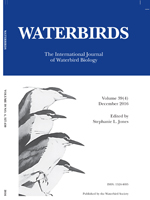The breeding parameters of the Black-faced Ibis (Theristicus melanopis) in pastures of southern Chile between 5 July and 30 November 2014 were evaluated. Thirty active nests were monitored in an area of 31 km2, using a mirror mounted on a 13-m retractable aluminum pole. Each nest was visited once a week. The Black-faced Ibis presented an asynchronous posture period, with a maximum of three egg clutches. The first eggs were laid on 6 August 2014, and the mean incubation period was 28.66 (± 4.41) days. Mean clutch size during the first posture was 2.23 (± 0.73) with a range of one to three eggs per nest. None of the structural parameters of the nesting site evaluated were related to clutch size. The nests were oriented with a mean angle of 218° SW. Hatching of the chicks began on 25 September 2014, and the mean period of parental care lasted 36.67 (± 14.49) days. The apparent hatching success was 0.54, the fledging success was 0.40, and the total breeding cycle success was 0.23 independent young per nest. Predation explained the 56.7% nest loss. Chimango Caracara (Milvago chimango) was the main predator of eggs and chicks. The Mayfield estimator indicated a daily survival probability of 4.4% for the incubation cycle, 26.2% for the fledglings and 11.3% for the total breeding cycle.
How to translate text using browser tools
1 December 2016
Breeding Biology of the Black-Faced Ibis (Theristicus melanopis) in Southern Chile
Alberto Gantz,
Miguel Yañez
ACCESS THE FULL ARTICLE

Waterbirds
Vol. 39 • No. 4
December 2016
Vol. 39 • No. 4
December 2016
breeding success
clutch size
ibis
Mayfield estimator
nest predation
pastures
reproduction




